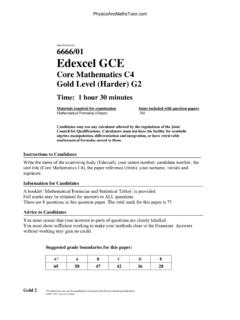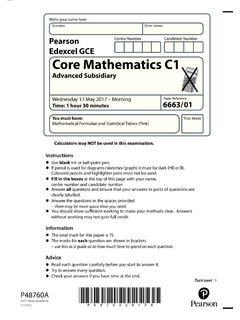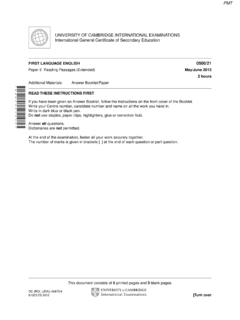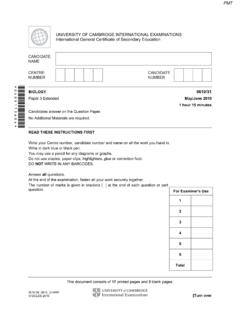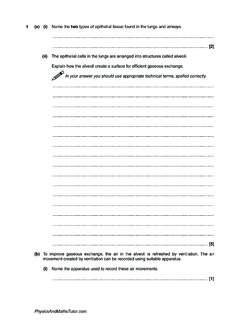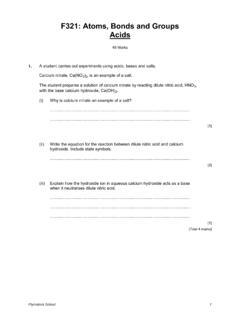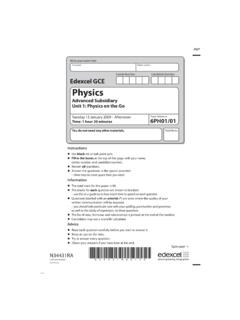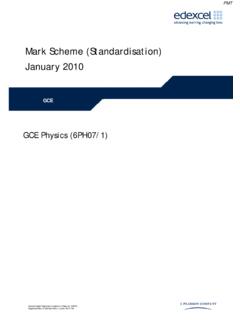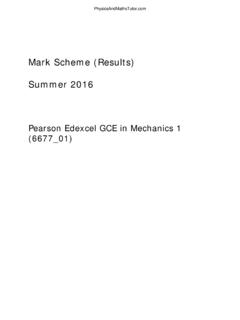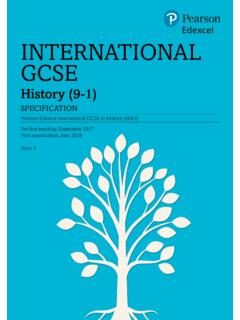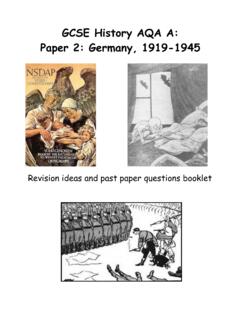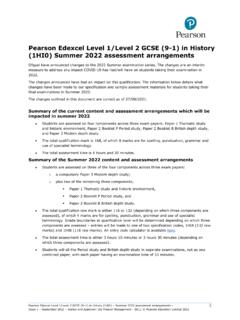Transcription of AQA English GCSE Poetry: Power and Conflict - PMT
1 AQA English gcse Poetry: Power and Conflict Ozymandias - Percy Shelley work by PMT Education is licensed under CC BY-NC-ND Percy Shelley Brief Summary The poem concerns the discovery of a semi-destroyed and decaying statue of Ramesses II, also known as Ozymandias, and shows how Power deteriorates and will not last forever. Synopsis Report from a stranger of a statue in a desert Statue is falling apart and decaying The sculptor has made it in a way that portrays the cruelty of the king King s pedestal claims he was "king of kings" shows his arrogance Irony of his claims when the statue is surrounded by endless featureless desert Context Percy Shelley (1772-1822) Shelley was a radical, romantic poet ; he was vegetarian, strongly anti-monarchy , a pacifist , an atheist , anti-religion , and supported social justice . He wanted to end the oppression of ordinary people, inspired by the French Revolution.
2 He got expelled from Oxford University for publishing an atheist pamphlet and delivering it to religious figures. At 19 he got married after running off from his first wife who killed herself. He came from a very wealthy family, and was set to have a comfortable life with inheritance and a government role from his grandfather. He was a second generation romantic. Romantic Era Shelley often focused focus on the subjective and the emotional, which contrasted with enlightenment values. During the enlightenment, writers would center their work on the beauty of nature and simplicity of the past, with an appreciation of the sublime, the overwhelming Power and awe of the natural world. Writers would protest the present/future of mankind by returning to the past, and within their writing repurpose old literary conventions. There was a rejection of institutions of Power , and poetry was used to spread messages and political ideas which needed to be accessible to all.
3 Historical influences in the poem The first reference is Ramesses II , who was an Egyptian pharaoh from 1279-1239 BC, in fact believed to be the pharaoh involved in Moses exodus. He was later defeated by the 12 tribes of Israel, and used the throne name Ozymandias . He is the subject of the poem his statue had just discovered at Shelley s time of writing, which made it a very topical piece of content to reference in his poem. Shelley and Horace Smith had been challenged to write a poem about it. Ramesses is remembered for his tyranny and military exploits, had a large empire over Egypt and vassals, as well as being remembered for his defeat. King George III arguably has impact over Shelley s poem, as his poem written during his reign; he had reigned longer than any king before, but had outstayed his welcome. He engaged in many military conflicts and was remembered for oppression and tyranny during his rule, the 13 colonies rebelled.
4 Shelley was pacifist and positioned himself against Georges military exploits. Some consider George III the inspiration for Ozymandias, who is seen historically as a tyrant. Ozymandias Shelley, one of the most famous poets of his time, explores Conflict in his poem Ozymandias, which was named after the Egyptian pharaoh, Rameses II. It is thought that Shelley, a radical romantic poet who often criticised society in his works, was making implicit links between Rameses powerful but violent rein with that of George III. George III reigned during the time the poem was written, and was generally disliked. George III has been seen historically as a tyrant. The poem engages in these issues of Power and Conflict through the discussion of a huge statue in the desert, which is of Ozymandias. All of the pharaoh s works haven t lasted, and the statue is almost destroyed. This decay reflects how exploits which are impressive but not morally good will be criticised and forgotten about after they end.
5 The poem explores Conflict between man and time and memory, as Ozymandias was largely forgotten, even though he thought his memory would last forever. The poem also touches on the Power of art and words, as people may not have remembered Ozymandias, but part of the statue remained, as well as the words placed on the inscription. Overall, the message of the poem could be considered to be a reminder that Power will not last forever. Ozymandias Desert suggests a lifelessness and lack of culture. The image of a shattered visage creates a sense of irony: a King who believed so strongly in his own Power and superiority, and who tried so hard to present this image of greatness through his statue, has now been forgotten and destroyed by time other than the visage that had been intended to show he was unforgettable. contemptuous/mocking smile, remark or tone, which connotes malicious cruelty and heartless. It s like he is mocking his subjects, and hows his insolence and contempt for subjects that he views as below him.
6 This presents the King s arrogance, confidence and sense of superiority. This is reflective of Shelley s own anti-violence stance, as he was against all military exploits and thus also against the cold commands that initiate them. I met a traveller from an antique land Who said: Two vast and trunkless legs of stone Stand in the desert . Near them on the sand, Half sunk, a shatter d visage lies, whose frown And wrinkled lip and sneer of cold command Tell that its sculptor well those passions read Which yet survive, stamp d on these lifeless things, The hand that mock d them and the heart that fed; And on the pedestal these words appear: Legacy is so insignificant it is known only by travellers Egypt is seen as an antique land (failed in trying to increase influence). A wrinkled lip conjures the image of someone grimacing in disgust and contempt, thus displaying the king s disregard for his subjects, viewing them as inferior and below him.
7 This antipathy is then paired with immense Power which enables him to exploit and torture the people he rules with no empathy or remorse. Shelley can use this to show the danger of a single individual having unlimited Power invested in them (be it political or religious), as it enables them to see all other people as inferior and thus derive an ability to oppress them. The artist s work is mocking the king. Sees glory in a statue that is criticising, yet his confidence in his own supremacy means he overlooks any evidence that contradicts their grandeur. Mocked can also be interpreted as to make a model of as the Irony of pedestal message: pedestal by idiomatic connotation presents his Power as undeserved has literally made a model of the king - perhaps it was not his intention to portray him negatively he had a heart that fed the king through its intention to please him - but that simply by modelling Ozymandias, it was inevitable that his cruelty would show due to it being an inextricable part of him.
8 My name is Ozymandias, king of kings : Look on my works , ye Mighty, and despair! Nothing beside remains. Round the decay Of that colossal wreck, boundless and bare , The lone and level sands stretch far away This claim seems ironic to the reader when they are known only via the report of a traveller. Ozymandias pride and arrogance led to his perception of himself as the king of kings : criticizes leaders and their ideas of themselves and ability to rule suggests he views himself as omnipotent. The King clearly expects his empire and kingdom to survive, which is dramatic irony. Level - monotonous and featureless no sign of his legacy. Lone isolated statue is all that remains his cruelty is only remembrance. These are also alliterative. The literal sand has covered over Ozymandias statue; the figurative sands of time have covered over Ozymandias memory. Alliterative The statue is in a far away where it stands so insignificant and unrecognised that only travellers know it exists.
9 Egypt (the statue of the poem exists, and originated from the Ramesseum in Egypt) which Ozymandias had tried so hard to extend and pursuits are condemned to failure when the insignificance of Egypt allows it to be dismissively deemed far away title Ozymandias Perspective The poem is written from the first person perspective , however, the speaker is never revealed nor named nor assigned any identifying characteristics. In this respect he can be considered an omniscient speaker. The pronoun I is only used once in the poem, right at the start, which shows how little the perspective actually matters. This may be intentionally to disconnect the speaker from Shelley, as he was attempting to impart a political message through his work. Through disguising this as a message from a fictional character he is removing any blame that society may try and pin on him, as the writer. The opening I met a traveller from an antique land The poem begins with I met a traveller which Instantly passes any responsibility for the opinions within the poem onto a (probably fictional) stranger.
10 Shelley opens his poem with the detached narrative of a traveller to distance himself from the political messages of his poem. Shelley uses Ozymandias as an allegory for King George III. This shows readers that he s willing to risk criticism that would have come with this move. This detachment means Shelley is free to comment on the monarchy or religion as he wishes for the rest of the poem because the views are being presented as the views of someone else. Equally, having the poem communicated by reported speech serves to trivialise the reign of Ozymandias. Structure Rhyme Scheme The irregular rhyme scheme contrasts with the single stanza as the former suggests a lack of Power and control of the ruler, whereas the single stanza suggests order. These contrasts could reflect how different groups of people view war and Conflict as either beneficial or detrimental to society. Sonnet The poem blends Petrarchan and Shakespearean sonnets , and Shelley does this in order to demonstrate that all Power even the Power of literary conventions is transient and subject to evolution.
